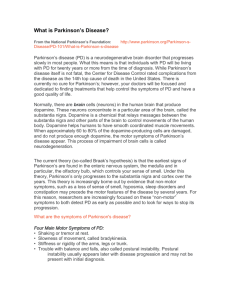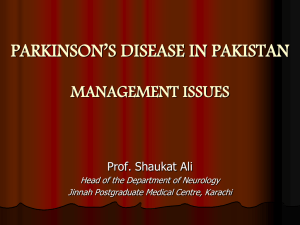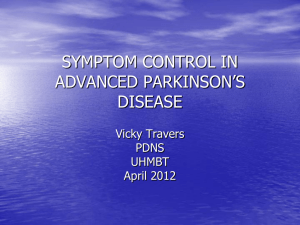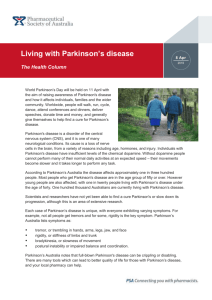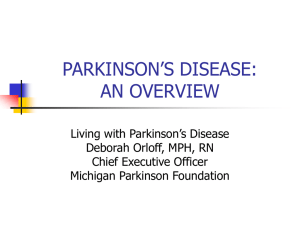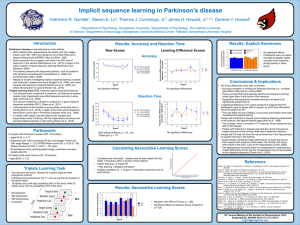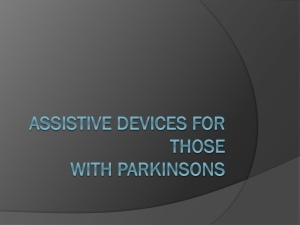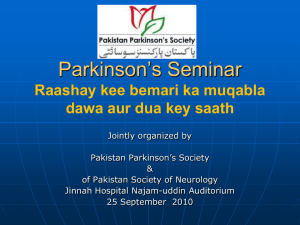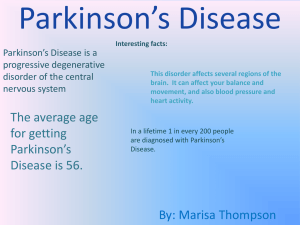Parkinson`s Disease
advertisement
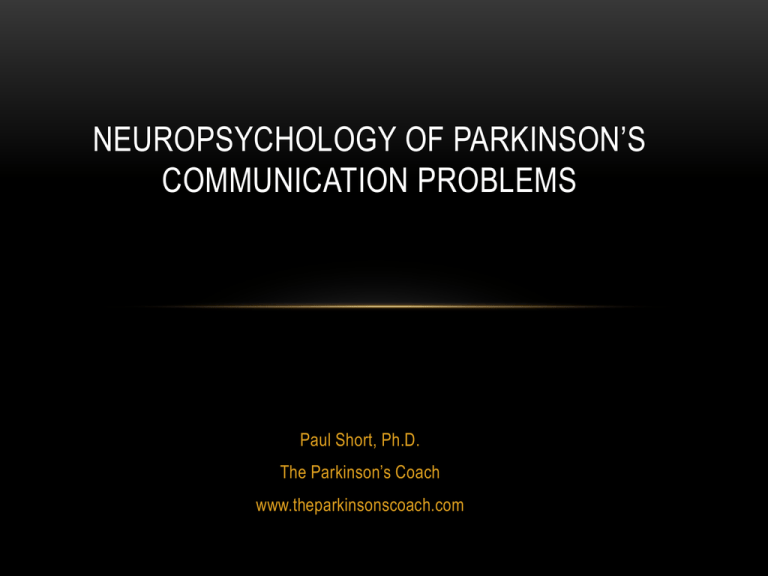
NEUROPSYCHOLOGY OF PARKINSON’S COMMUNICATION PROBLEMS Paul Short, Ph.D. The Parkinson’s Coach www.theparkinsonscoach.com WHAT IS PARKINSON’S DISEASE? PARKINSON’S DISEASE (PD) • A Movement Disorder Marked by varying combinations of • Tremor • Bradykinesia • Muscle Rigidity • Postural Instability PARKINSON’S DISEASE (PD) • Centered in upper midbrain in the Substantia Nigra PARKINSON’S DISEASE (PD) • Substantia Nigra experiences loss of neurons producing the neurotransmitter dopamine PARKINSON’S DISEASE (PD) • Centered in the upper brain stem in the Substantia Nigra LIVING IN THE WORLD OF PARKINSON’S TREATMENT OF PARKINSON’S DISEASE • Exercise • Diet & Nutrition • Stress Management • Education • Social Support EARLY STAGE PARKINSON’S TREATMENTS • Amantadine • Side Effects/Complications DOPAMINE AUGMENTATION • Dopamine Agonists • Mirapex • Requip • Side Effects/Complications • Sudden sleep (Mirapex) • Potential for inccrease compulsivity DOPAMINE REPLACEMENT • Levodopa • Dopamine will not cross blood-brain barrier • Precursor for dopamine can be transmitted to CNS • Can cause nausea so combined with carbadopa • Carbadopa/Levodopa is the primary treatment for advanced PD DOPAMINE REPLACEMENT • Complications/problems • Protein can interfere with absorbtion • Sensitivity can cause dyskinesias and dystonias over time. DEEP BRAIN STIMULATION • Surgery implants leads into mid-brain structures • usually the subthalamic nucleus or globus pallidus • Patient awake during surgery • Treatment must be done by a skilled programmer DEEP BRAIN STIMULATION • Advantages • Constant stimulation much like steady dopamine treatment • Manages medication-induce dyskinesias • Programming can be done far into the disease process DEEP BRAIN STIMULATION • Disadvantages/complications • Can affect memory and verbal fluency • Generally not recommended for patients with dementia • Best programming sometimes causes dysarthria • Cannot have MRIs PARKINSONISM- THE “PARKINSON’S PLUS” SYNDROMES • Parkinson’s like movement disorder with other medical concerns • Typically more severe than PD • Sometimes not as responsive to regular PD treatments • Death often occurs several years after diagnosis PARKINSONISM- THE “PARKINSON’S PLUS” SYNDROMES • Progressive Supranuclear Palsy (PSP) • Bradykinesia and rigidity without tremor • Postural instability with falling early in disease course • Gaze palsy • Dysphonia, dysphagia, dysarthria, chewing problems • Cognitive problems • Slowed thought process, forgetfulness • Executive dysfunction such as perseveration • Personality changes (apathy, irritability) PARKINSONISM- THE “PARKINSON’S PLUS” SYNDROMES • Multiple Systems Atrophy (MSA) • Tremor, Rigidity, Loss of Muscle Coordination • Autonomic dysfunction such as fainting, loss of bladder control, temperature regulation, and blood pressure • Speech problems such as vocal cord paralysis • Dysphonia, dysphagia, dysarthria, chewing problems • Less Cognitive involvement than PD and PD+ • Attentional problems and slowed thinking • Executive dysfunction such as set-shifting • Some verbal fluency concerns PARKINSONISM- THE “PARKINSON’S PLUS” SYNDROMES • Corticobasal Degeneration (CBD) • Akinesia, Rigidity, Balance Problems, Apraxia, Myoclonus • Problems with Speech Fluency and Dysphagia • Cognitive Changes (Variable) • Sustained Attentional problems • Phonological deficits and progressive non-fluent aphasia • Dementia in Later Stages PARKINSONISM- THE “PARKINSON’S PLUS” SYNDROMES • Parkinson’s Disease Dementia (PDD) & Dementia with Lewy Bodies (DLB) • Both involve Lewy Bodies • PDD is a progression from PD but in DLB motor symptoms tend to occur only a year or two before cognitive dysfunction • More common in older onset patients with rigidity, gait, and postural disorders. • Rarer in tremor-dominant onset PARKINSONISM- THE “PARKINSON’S PLUS” SYNDROMES • Parkinson’s Disease Dementia (PDD) & Dementia with Lewy Bodies (DLB) • REM sleep behavior disorder very common • Recurrent Visual Hallucinations • Fluctuating cognition, primarily variable attention and focus • Perception problems primarily visuospatial • Memory Problems • Executive dysfunction • Problems with semantic fluency • Abstract reasoning and cognitive flexibility DIMINISHED COMMUNICATION IN PARKINSON’S DISEASE EXPRESSIVE COMMUNICATION DEFICITS WITH PARKINSON’S DISEASE • Diminished prosody • Hypophonia • Reduced social contact RECEPTIVE COMMUNICATION DEFICITS IN PD DIMINISHED EMOTION DECODING • Diminished emotion decoding • Many individuals with PD have difficulty: • Interpreting emotions implied by facial expression. • Interpreting emotions implied by vocal intonation and prosody • Alexithymia- tendency not to think about emotion RECEPTIVE COMMUNICATION DEFICITS IN PD • Diminished emotion decoding • Many individuals with PD have difficulty: • Interpreting emotions implied by facial expression. • Interpreting emotions implied by vocal intonation and prosody RECEPTIVE COMMUNICATION DEFICITS IN PD DIMINISHED EMOTION DECODING • Diminished emotion decoding • Many individuals with PD have difficulty: • Interpreting emotions implied by facial expression. • Interpreting emotions implied by vocal intonation and prosody • Being attuned to emotional signals in general (alexithymia) RECEPTIVE COMMUNICATION DEFICITS IN PD EXECUTIVE DYSFUNCTION • Executive function deficits impacting communication • Impaired Verbal Fluency • Difficulties with organization and execution • Anhedonia • Metacogntion RECEPTIVE COMMUNICATION DEFICITS IN PD DEMENTIA • Many of the communication problems of dementia reflect more severe executive dysfunciton

